NUR3201 Assignment 1: Electronic Documentation and Troy Almond Case
VerifiedAdded on 2022/09/23
|9
|2782
|22
Report
AI Summary
This report examines the critical role of electronic documentation in nursing, emphasizing accountability and patient safety. It analyzes the case of Troy Almond, highlighting failures in electronic communication and missed opportunities for care. The report discusses the accountability requirements of registered nurses in electronic communication, including maintaining documentation integrity, using appropriate patient identification, and ensuring timely access to electronic health records. It identifies gaps in care, such as delayed vital sign documentation, incomplete vital signs, and failure to adhere to the 'Between the Flags' (BTF) system and paediatric sepsis pathways. The analysis reveals how these failures contributed to Troy's death, emphasizing the importance of accurate communication, teamwork, and adherence to established policies. The report recommends vital sign assessment using the BTF system, education on complete and frequent vital signs assessment, and appropriate use of escalation systems like REACH to mitigate risks and prevent similar incidents in the future. The overall conclusion emphasizes the impact of inappropriate documentation on patient outcomes and highlights lessons for improved healthcare practices.

Running head: NURSING
Nursing
Name of the student:
Name of the University:
Author’s note
Nursing
Name of the student:
Name of the University:
Author’s note
Paraphrase This Document
Need a fresh take? Get an instant paraphrase of this document with our AI Paraphraser
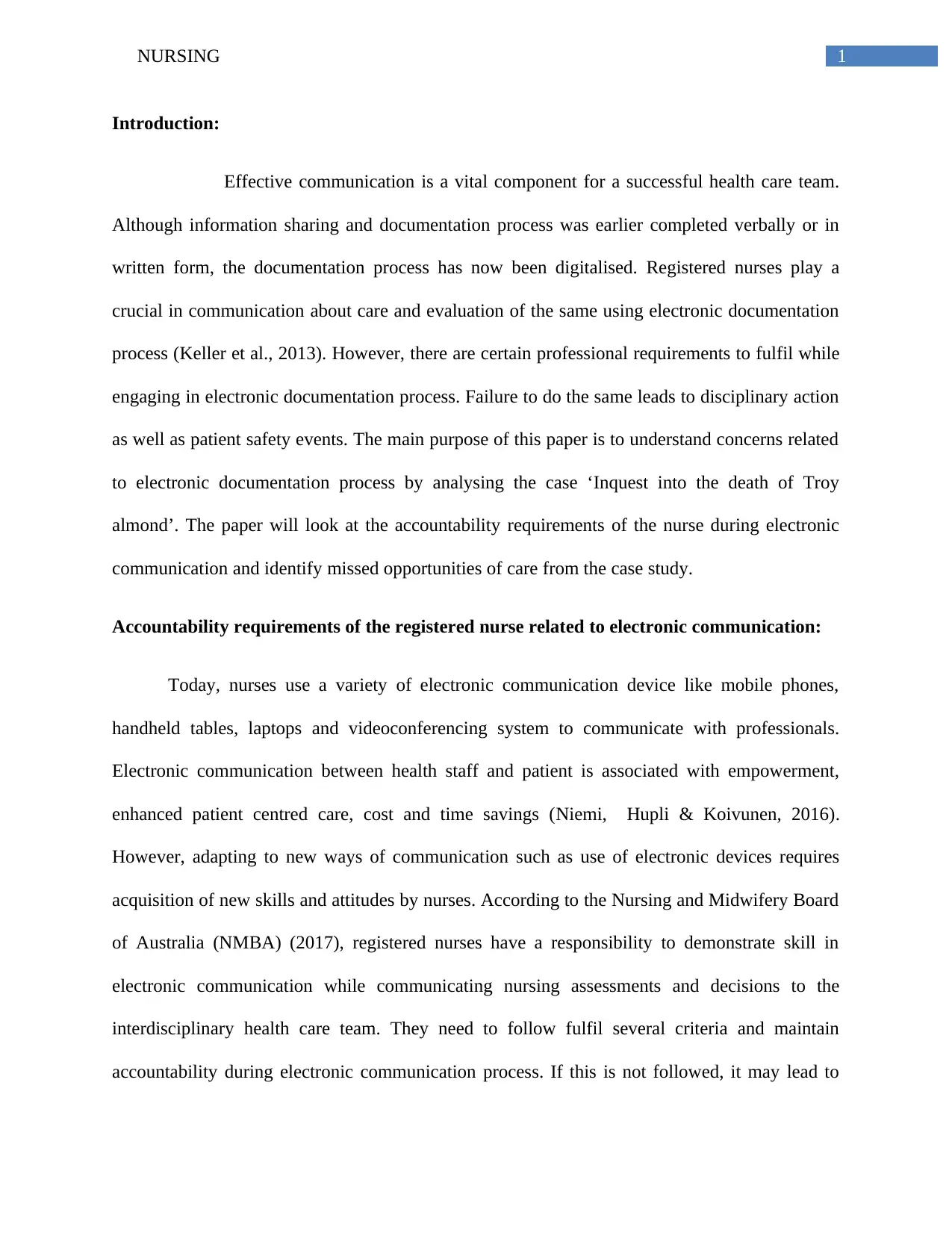
1NURSING
Introduction:
Effective communication is a vital component for a successful health care team.
Although information sharing and documentation process was earlier completed verbally or in
written form, the documentation process has now been digitalised. Registered nurses play a
crucial in communication about care and evaluation of the same using electronic documentation
process (Keller et al., 2013). However, there are certain professional requirements to fulfil while
engaging in electronic documentation process. Failure to do the same leads to disciplinary action
as well as patient safety events. The main purpose of this paper is to understand concerns related
to electronic documentation process by analysing the case ‘Inquest into the death of Troy
almond’. The paper will look at the accountability requirements of the nurse during electronic
communication and identify missed opportunities of care from the case study.
Accountability requirements of the registered nurse related to electronic communication:
Today, nurses use a variety of electronic communication device like mobile phones,
handheld tables, laptops and videoconferencing system to communicate with professionals.
Electronic communication between health staff and patient is associated with empowerment,
enhanced patient centred care, cost and time savings (Niemi, Hupli & Koivunen, 2016).
However, adapting to new ways of communication such as use of electronic devices requires
acquisition of new skills and attitudes by nurses. According to the Nursing and Midwifery Board
of Australia (NMBA) (2017), registered nurses have a responsibility to demonstrate skill in
electronic communication while communicating nursing assessments and decisions to the
interdisciplinary health care team. They need to follow fulfil several criteria and maintain
accountability during electronic communication process. If this is not followed, it may lead to
Introduction:
Effective communication is a vital component for a successful health care team.
Although information sharing and documentation process was earlier completed verbally or in
written form, the documentation process has now been digitalised. Registered nurses play a
crucial in communication about care and evaluation of the same using electronic documentation
process (Keller et al., 2013). However, there are certain professional requirements to fulfil while
engaging in electronic documentation process. Failure to do the same leads to disciplinary action
as well as patient safety events. The main purpose of this paper is to understand concerns related
to electronic documentation process by analysing the case ‘Inquest into the death of Troy
almond’. The paper will look at the accountability requirements of the nurse during electronic
communication and identify missed opportunities of care from the case study.
Accountability requirements of the registered nurse related to electronic communication:
Today, nurses use a variety of electronic communication device like mobile phones,
handheld tables, laptops and videoconferencing system to communicate with professionals.
Electronic communication between health staff and patient is associated with empowerment,
enhanced patient centred care, cost and time savings (Niemi, Hupli & Koivunen, 2016).
However, adapting to new ways of communication such as use of electronic devices requires
acquisition of new skills and attitudes by nurses. According to the Nursing and Midwifery Board
of Australia (NMBA) (2017), registered nurses have a responsibility to demonstrate skill in
electronic communication while communicating nursing assessments and decisions to the
interdisciplinary health care team. They need to follow fulfil several criteria and maintain
accountability during electronic communication process. If this is not followed, it may lead to
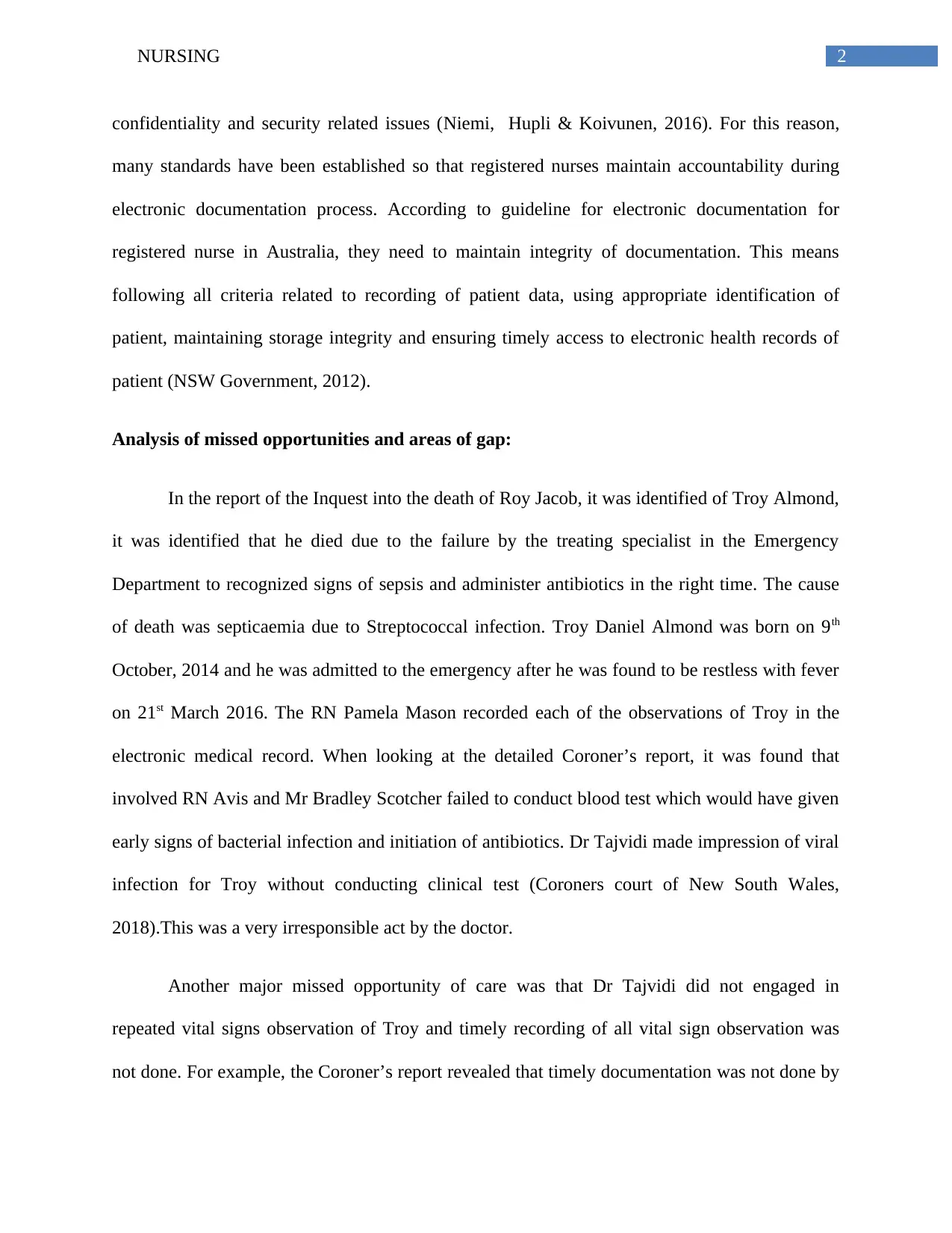
2NURSING
confidentiality and security related issues (Niemi, Hupli & Koivunen, 2016). For this reason,
many standards have been established so that registered nurses maintain accountability during
electronic documentation process. According to guideline for electronic documentation for
registered nurse in Australia, they need to maintain integrity of documentation. This means
following all criteria related to recording of patient data, using appropriate identification of
patient, maintaining storage integrity and ensuring timely access to electronic health records of
patient (NSW Government, 2012).
Analysis of missed opportunities and areas of gap:
In the report of the Inquest into the death of Roy Jacob, it was identified of Troy Almond,
it was identified that he died due to the failure by the treating specialist in the Emergency
Department to recognized signs of sepsis and administer antibiotics in the right time. The cause
of death was septicaemia due to Streptococcal infection. Troy Daniel Almond was born on 9th
October, 2014 and he was admitted to the emergency after he was found to be restless with fever
on 21st March 2016. The RN Pamela Mason recorded each of the observations of Troy in the
electronic medical record. When looking at the detailed Coroner’s report, it was found that
involved RN Avis and Mr Bradley Scotcher failed to conduct blood test which would have given
early signs of bacterial infection and initiation of antibiotics. Dr Tajvidi made impression of viral
infection for Troy without conducting clinical test (Coroners court of New South Wales,
2018).This was a very irresponsible act by the doctor.
Another major missed opportunity of care was that Dr Tajvidi did not engaged in
repeated vital signs observation of Troy and timely recording of all vital sign observation was
not done. For example, the Coroner’s report revealed that timely documentation was not done by
confidentiality and security related issues (Niemi, Hupli & Koivunen, 2016). For this reason,
many standards have been established so that registered nurses maintain accountability during
electronic documentation process. According to guideline for electronic documentation for
registered nurse in Australia, they need to maintain integrity of documentation. This means
following all criteria related to recording of patient data, using appropriate identification of
patient, maintaining storage integrity and ensuring timely access to electronic health records of
patient (NSW Government, 2012).
Analysis of missed opportunities and areas of gap:
In the report of the Inquest into the death of Roy Jacob, it was identified of Troy Almond,
it was identified that he died due to the failure by the treating specialist in the Emergency
Department to recognized signs of sepsis and administer antibiotics in the right time. The cause
of death was septicaemia due to Streptococcal infection. Troy Daniel Almond was born on 9th
October, 2014 and he was admitted to the emergency after he was found to be restless with fever
on 21st March 2016. The RN Pamela Mason recorded each of the observations of Troy in the
electronic medical record. When looking at the detailed Coroner’s report, it was found that
involved RN Avis and Mr Bradley Scotcher failed to conduct blood test which would have given
early signs of bacterial infection and initiation of antibiotics. Dr Tajvidi made impression of viral
infection for Troy without conducting clinical test (Coroners court of New South Wales,
2018).This was a very irresponsible act by the doctor.
Another major missed opportunity of care was that Dr Tajvidi did not engaged in
repeated vital signs observation of Troy and timely recording of all vital sign observation was
not done. For example, the Coroner’s report revealed that timely documentation was not done by
⊘ This is a preview!⊘
Do you want full access?
Subscribe today to unlock all pages.

Trusted by 1+ million students worldwide
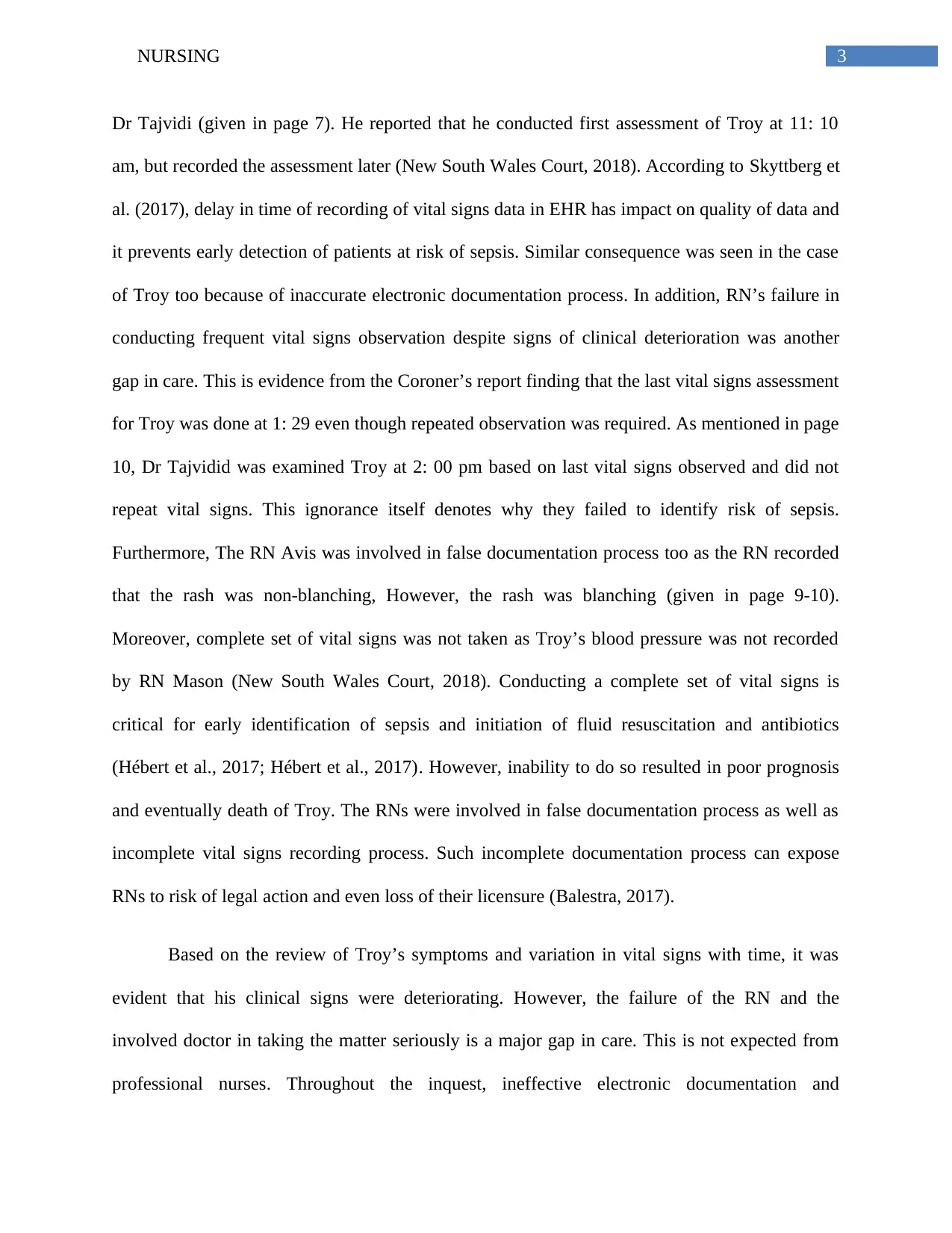
3NURSING
Dr Tajvidi (given in page 7). He reported that he conducted first assessment of Troy at 11: 10
am, but recorded the assessment later (New South Wales Court, 2018). According to Skyttberg et
al. (2017), delay in time of recording of vital signs data in EHR has impact on quality of data and
it prevents early detection of patients at risk of sepsis. Similar consequence was seen in the case
of Troy too because of inaccurate electronic documentation process. In addition, RN’s failure in
conducting frequent vital signs observation despite signs of clinical deterioration was another
gap in care. This is evidence from the Coroner’s report finding that the last vital signs assessment
for Troy was done at 1: 29 even though repeated observation was required. As mentioned in page
10, Dr Tajvidid was examined Troy at 2: 00 pm based on last vital signs observed and did not
repeat vital signs. This ignorance itself denotes why they failed to identify risk of sepsis.
Furthermore, The RN Avis was involved in false documentation process too as the RN recorded
that the rash was non-blanching, However, the rash was blanching (given in page 9-10).
Moreover, complete set of vital signs was not taken as Troy’s blood pressure was not recorded
by RN Mason (New South Wales Court, 2018). Conducting a complete set of vital signs is
critical for early identification of sepsis and initiation of fluid resuscitation and antibiotics
(Hébert et al., 2017; Hébert et al., 2017). However, inability to do so resulted in poor prognosis
and eventually death of Troy. The RNs were involved in false documentation process as well as
incomplete vital signs recording process. Such incomplete documentation process can expose
RNs to risk of legal action and even loss of their licensure (Balestra, 2017).
Based on the review of Troy’s symptoms and variation in vital signs with time, it was
evident that his clinical signs were deteriorating. However, the failure of the RN and the
involved doctor in taking the matter seriously is a major gap in care. This is not expected from
professional nurses. Throughout the inquest, ineffective electronic documentation and
Dr Tajvidi (given in page 7). He reported that he conducted first assessment of Troy at 11: 10
am, but recorded the assessment later (New South Wales Court, 2018). According to Skyttberg et
al. (2017), delay in time of recording of vital signs data in EHR has impact on quality of data and
it prevents early detection of patients at risk of sepsis. Similar consequence was seen in the case
of Troy too because of inaccurate electronic documentation process. In addition, RN’s failure in
conducting frequent vital signs observation despite signs of clinical deterioration was another
gap in care. This is evidence from the Coroner’s report finding that the last vital signs assessment
for Troy was done at 1: 29 even though repeated observation was required. As mentioned in page
10, Dr Tajvidid was examined Troy at 2: 00 pm based on last vital signs observed and did not
repeat vital signs. This ignorance itself denotes why they failed to identify risk of sepsis.
Furthermore, The RN Avis was involved in false documentation process too as the RN recorded
that the rash was non-blanching, However, the rash was blanching (given in page 9-10).
Moreover, complete set of vital signs was not taken as Troy’s blood pressure was not recorded
by RN Mason (New South Wales Court, 2018). Conducting a complete set of vital signs is
critical for early identification of sepsis and initiation of fluid resuscitation and antibiotics
(Hébert et al., 2017; Hébert et al., 2017). However, inability to do so resulted in poor prognosis
and eventually death of Troy. The RNs were involved in false documentation process as well as
incomplete vital signs recording process. Such incomplete documentation process can expose
RNs to risk of legal action and even loss of their licensure (Balestra, 2017).
Based on the review of Troy’s symptoms and variation in vital signs with time, it was
evident that his clinical signs were deteriorating. However, the failure of the RN and the
involved doctor in taking the matter seriously is a major gap in care. This is not expected from
professional nurses. Throughout the inquest, ineffective electronic documentation and
Paraphrase This Document
Need a fresh take? Get an instant paraphrase of this document with our AI Paraphraser
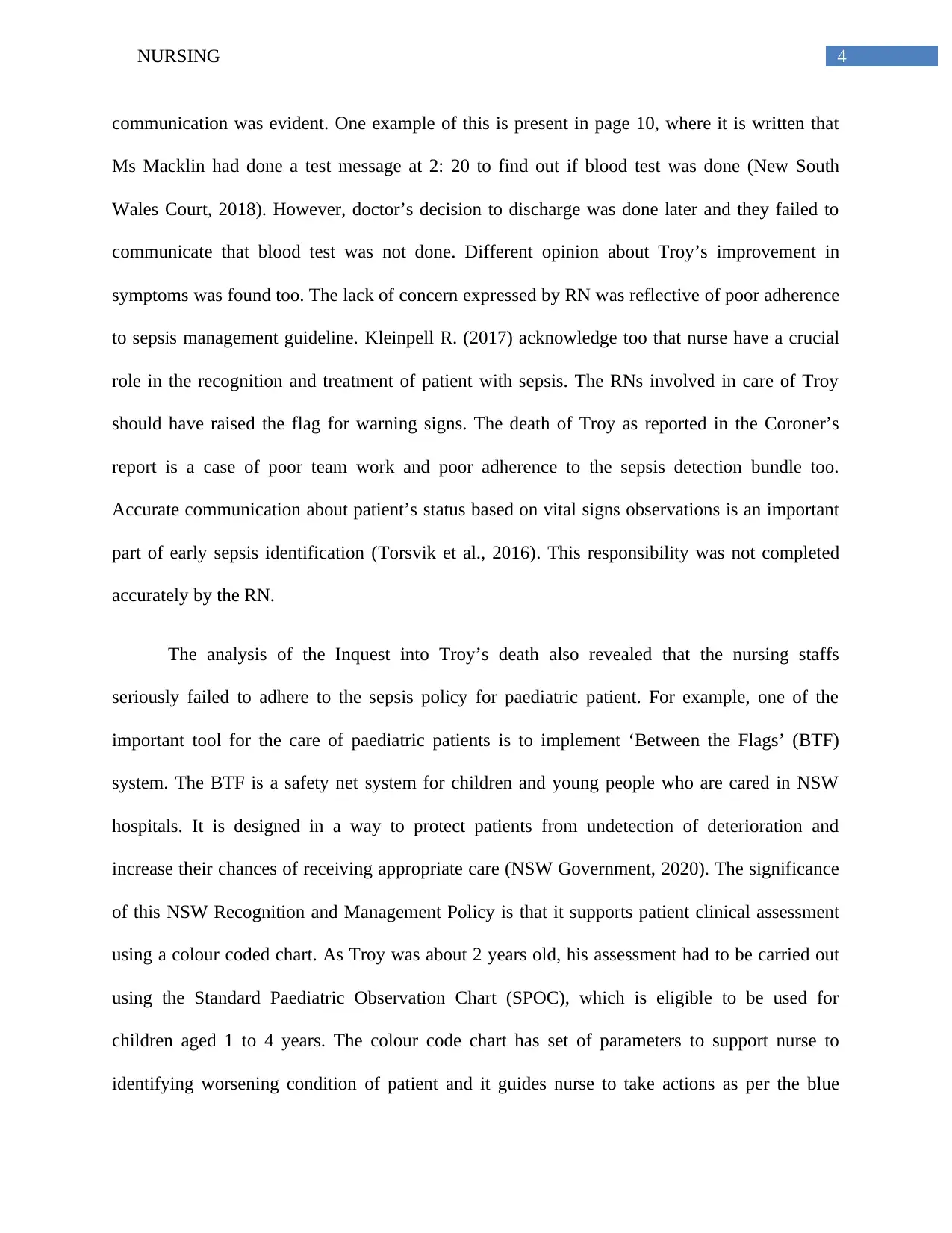
4NURSING
communication was evident. One example of this is present in page 10, where it is written that
Ms Macklin had done a test message at 2: 20 to find out if blood test was done (New South
Wales Court, 2018). However, doctor’s decision to discharge was done later and they failed to
communicate that blood test was not done. Different opinion about Troy’s improvement in
symptoms was found too. The lack of concern expressed by RN was reflective of poor adherence
to sepsis management guideline. Kleinpell R. (2017) acknowledge too that nurse have a crucial
role in the recognition and treatment of patient with sepsis. The RNs involved in care of Troy
should have raised the flag for warning signs. The death of Troy as reported in the Coroner’s
report is a case of poor team work and poor adherence to the sepsis detection bundle too.
Accurate communication about patient’s status based on vital signs observations is an important
part of early sepsis identification (Torsvik et al., 2016). This responsibility was not completed
accurately by the RN.
The analysis of the Inquest into Troy’s death also revealed that the nursing staffs
seriously failed to adhere to the sepsis policy for paediatric patient. For example, one of the
important tool for the care of paediatric patients is to implement ‘Between the Flags’ (BTF)
system. The BTF is a safety net system for children and young people who are cared in NSW
hospitals. It is designed in a way to protect patients from undetection of deterioration and
increase their chances of receiving appropriate care (NSW Government, 2020). The significance
of this NSW Recognition and Management Policy is that it supports patient clinical assessment
using a colour coded chart. As Troy was about 2 years old, his assessment had to be carried out
using the Standard Paediatric Observation Chart (SPOC), which is eligible to be used for
children aged 1 to 4 years. The colour code chart has set of parameters to support nurse to
identifying worsening condition of patient and it guides nurse to take actions as per the blue
communication was evident. One example of this is present in page 10, where it is written that
Ms Macklin had done a test message at 2: 20 to find out if blood test was done (New South
Wales Court, 2018). However, doctor’s decision to discharge was done later and they failed to
communicate that blood test was not done. Different opinion about Troy’s improvement in
symptoms was found too. The lack of concern expressed by RN was reflective of poor adherence
to sepsis management guideline. Kleinpell R. (2017) acknowledge too that nurse have a crucial
role in the recognition and treatment of patient with sepsis. The RNs involved in care of Troy
should have raised the flag for warning signs. The death of Troy as reported in the Coroner’s
report is a case of poor team work and poor adherence to the sepsis detection bundle too.
Accurate communication about patient’s status based on vital signs observations is an important
part of early sepsis identification (Torsvik et al., 2016). This responsibility was not completed
accurately by the RN.
The analysis of the Inquest into Troy’s death also revealed that the nursing staffs
seriously failed to adhere to the sepsis policy for paediatric patient. For example, one of the
important tool for the care of paediatric patients is to implement ‘Between the Flags’ (BTF)
system. The BTF is a safety net system for children and young people who are cared in NSW
hospitals. It is designed in a way to protect patients from undetection of deterioration and
increase their chances of receiving appropriate care (NSW Government, 2020). The significance
of this NSW Recognition and Management Policy is that it supports patient clinical assessment
using a colour coded chart. As Troy was about 2 years old, his assessment had to be carried out
using the Standard Paediatric Observation Chart (SPOC), which is eligible to be used for
children aged 1 to 4 years. The colour code chart has set of parameters to support nurse to
identifying worsening condition of patient and it guides nurse to take actions as per the blue
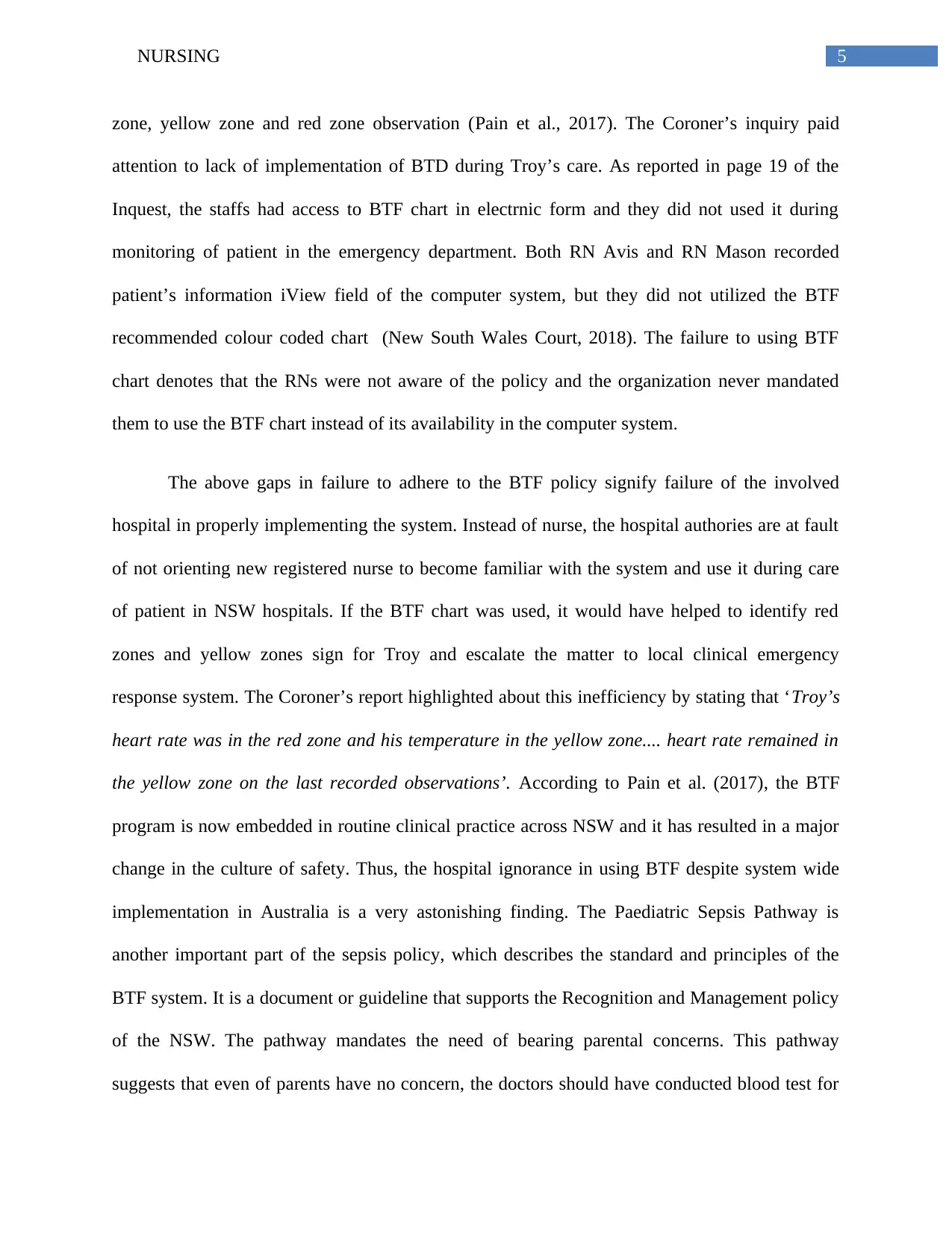
5NURSING
zone, yellow zone and red zone observation (Pain et al., 2017). The Coroner’s inquiry paid
attention to lack of implementation of BTD during Troy’s care. As reported in page 19 of the
Inquest, the staffs had access to BTF chart in electrnic form and they did not used it during
monitoring of patient in the emergency department. Both RN Avis and RN Mason recorded
patient’s information iView field of the computer system, but they did not utilized the BTF
recommended colour coded chart (New South Wales Court, 2018). The failure to using BTF
chart denotes that the RNs were not aware of the policy and the organization never mandated
them to use the BTF chart instead of its availability in the computer system.
The above gaps in failure to adhere to the BTF policy signify failure of the involved
hospital in properly implementing the system. Instead of nurse, the hospital authories are at fault
of not orienting new registered nurse to become familiar with the system and use it during care
of patient in NSW hospitals. If the BTF chart was used, it would have helped to identify red
zones and yellow zones sign for Troy and escalate the matter to local clinical emergency
response system. The Coroner’s report highlighted about this inefficiency by stating that ‘Troy’s
heart rate was in the red zone and his temperature in the yellow zone.... heart rate remained in
the yellow zone on the last recorded observations’. According to Pain et al. (2017), the BTF
program is now embedded in routine clinical practice across NSW and it has resulted in a major
change in the culture of safety. Thus, the hospital ignorance in using BTF despite system wide
implementation in Australia is a very astonishing finding. The Paediatric Sepsis Pathway is
another important part of the sepsis policy, which describes the standard and principles of the
BTF system. It is a document or guideline that supports the Recognition and Management policy
of the NSW. The pathway mandates the need of bearing parental concerns. This pathway
suggests that even of parents have no concern, the doctors should have conducted blood test for
zone, yellow zone and red zone observation (Pain et al., 2017). The Coroner’s inquiry paid
attention to lack of implementation of BTD during Troy’s care. As reported in page 19 of the
Inquest, the staffs had access to BTF chart in electrnic form and they did not used it during
monitoring of patient in the emergency department. Both RN Avis and RN Mason recorded
patient’s information iView field of the computer system, but they did not utilized the BTF
recommended colour coded chart (New South Wales Court, 2018). The failure to using BTF
chart denotes that the RNs were not aware of the policy and the organization never mandated
them to use the BTF chart instead of its availability in the computer system.
The above gaps in failure to adhere to the BTF policy signify failure of the involved
hospital in properly implementing the system. Instead of nurse, the hospital authories are at fault
of not orienting new registered nurse to become familiar with the system and use it during care
of patient in NSW hospitals. If the BTF chart was used, it would have helped to identify red
zones and yellow zones sign for Troy and escalate the matter to local clinical emergency
response system. The Coroner’s report highlighted about this inefficiency by stating that ‘Troy’s
heart rate was in the red zone and his temperature in the yellow zone.... heart rate remained in
the yellow zone on the last recorded observations’. According to Pain et al. (2017), the BTF
program is now embedded in routine clinical practice across NSW and it has resulted in a major
change in the culture of safety. Thus, the hospital ignorance in using BTF despite system wide
implementation in Australia is a very astonishing finding. The Paediatric Sepsis Pathway is
another important part of the sepsis policy, which describes the standard and principles of the
BTF system. It is a document or guideline that supports the Recognition and Management policy
of the NSW. The pathway mandates the need of bearing parental concerns. This pathway
suggests that even of parents have no concern, the doctors should have conducted blood test for
⊘ This is a preview!⊘
Do you want full access?
Subscribe today to unlock all pages.

Trusted by 1+ million students worldwide
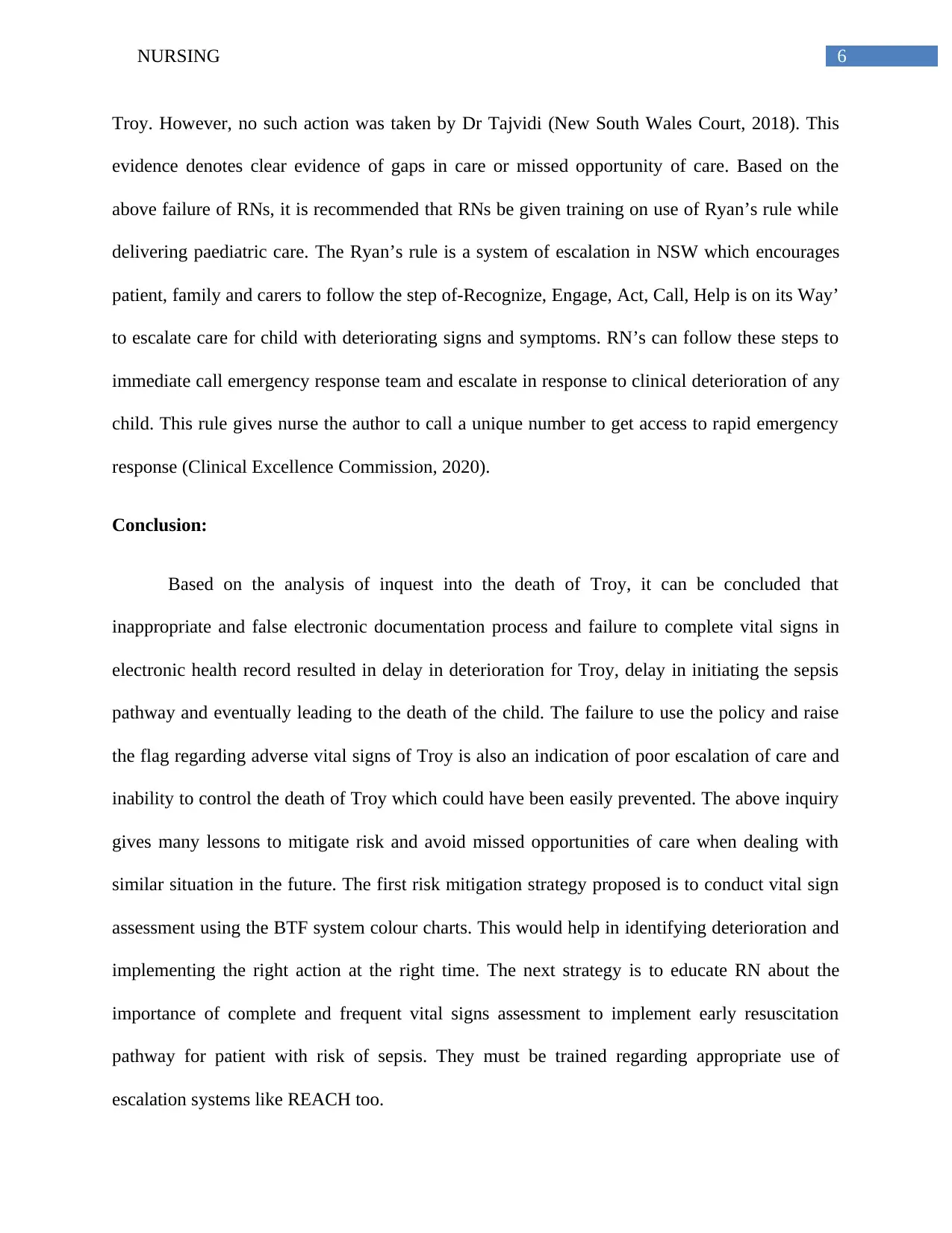
6NURSING
Troy. However, no such action was taken by Dr Tajvidi (New South Wales Court, 2018). This
evidence denotes clear evidence of gaps in care or missed opportunity of care. Based on the
above failure of RNs, it is recommended that RNs be given training on use of Ryan’s rule while
delivering paediatric care. The Ryan’s rule is a system of escalation in NSW which encourages
patient, family and carers to follow the step of-Recognize, Engage, Act, Call, Help is on its Way’
to escalate care for child with deteriorating signs and symptoms. RN’s can follow these steps to
immediate call emergency response team and escalate in response to clinical deterioration of any
child. This rule gives nurse the author to call a unique number to get access to rapid emergency
response (Clinical Excellence Commission, 2020).
Conclusion:
Based on the analysis of inquest into the death of Troy, it can be concluded that
inappropriate and false electronic documentation process and failure to complete vital signs in
electronic health record resulted in delay in deterioration for Troy, delay in initiating the sepsis
pathway and eventually leading to the death of the child. The failure to use the policy and raise
the flag regarding adverse vital signs of Troy is also an indication of poor escalation of care and
inability to control the death of Troy which could have been easily prevented. The above inquiry
gives many lessons to mitigate risk and avoid missed opportunities of care when dealing with
similar situation in the future. The first risk mitigation strategy proposed is to conduct vital sign
assessment using the BTF system colour charts. This would help in identifying deterioration and
implementing the right action at the right time. The next strategy is to educate RN about the
importance of complete and frequent vital signs assessment to implement early resuscitation
pathway for patient with risk of sepsis. They must be trained regarding appropriate use of
escalation systems like REACH too.
Troy. However, no such action was taken by Dr Tajvidi (New South Wales Court, 2018). This
evidence denotes clear evidence of gaps in care or missed opportunity of care. Based on the
above failure of RNs, it is recommended that RNs be given training on use of Ryan’s rule while
delivering paediatric care. The Ryan’s rule is a system of escalation in NSW which encourages
patient, family and carers to follow the step of-Recognize, Engage, Act, Call, Help is on its Way’
to escalate care for child with deteriorating signs and symptoms. RN’s can follow these steps to
immediate call emergency response team and escalate in response to clinical deterioration of any
child. This rule gives nurse the author to call a unique number to get access to rapid emergency
response (Clinical Excellence Commission, 2020).
Conclusion:
Based on the analysis of inquest into the death of Troy, it can be concluded that
inappropriate and false electronic documentation process and failure to complete vital signs in
electronic health record resulted in delay in deterioration for Troy, delay in initiating the sepsis
pathway and eventually leading to the death of the child. The failure to use the policy and raise
the flag regarding adverse vital signs of Troy is also an indication of poor escalation of care and
inability to control the death of Troy which could have been easily prevented. The above inquiry
gives many lessons to mitigate risk and avoid missed opportunities of care when dealing with
similar situation in the future. The first risk mitigation strategy proposed is to conduct vital sign
assessment using the BTF system colour charts. This would help in identifying deterioration and
implementing the right action at the right time. The next strategy is to educate RN about the
importance of complete and frequent vital signs assessment to implement early resuscitation
pathway for patient with risk of sepsis. They must be trained regarding appropriate use of
escalation systems like REACH too.
Paraphrase This Document
Need a fresh take? Get an instant paraphrase of this document with our AI Paraphraser
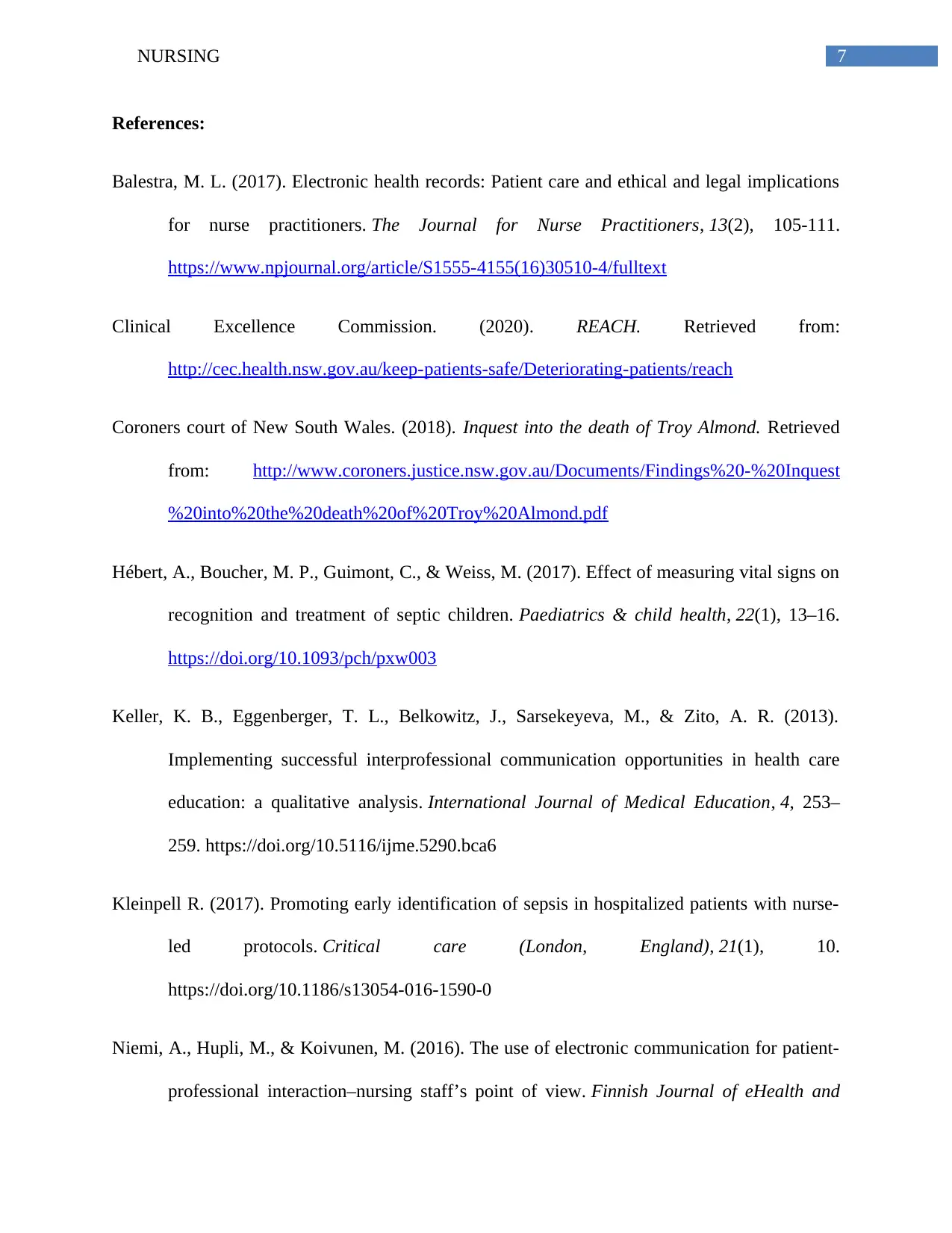
7NURSING
References:
Balestra, M. L. (2017). Electronic health records: Patient care and ethical and legal implications
for nurse practitioners. The Journal for Nurse Practitioners, 13(2), 105-111.
https://www.npjournal.org/article/S1555-4155(16)30510-4/fulltext
Clinical Excellence Commission. (2020). REACH. Retrieved from:
http://cec.health.nsw.gov.au/keep-patients-safe/Deteriorating-patients/reach
Coroners court of New South Wales. (2018). Inquest into the death of Troy Almond. Retrieved
from: http://www.coroners.justice.nsw.gov.au/Documents/Findings%20-%20Inquest
%20into%20the%20death%20of%20Troy%20Almond.pdf
Hébert, A., Boucher, M. P., Guimont, C., & Weiss, M. (2017). Effect of measuring vital signs on
recognition and treatment of septic children. Paediatrics & child health, 22(1), 13–16.
https://doi.org/10.1093/pch/pxw003
Keller, K. B., Eggenberger, T. L., Belkowitz, J., Sarsekeyeva, M., & Zito, A. R. (2013).
Implementing successful interprofessional communication opportunities in health care
education: a qualitative analysis. International Journal of Medical Education, 4, 253–
259. https://doi.org/10.5116/ijme.5290.bca6
Kleinpell R. (2017). Promoting early identification of sepsis in hospitalized patients with nurse-
led protocols. Critical care (London, England), 21(1), 10.
https://doi.org/10.1186/s13054-016-1590-0
Niemi, A., Hupli, M., & Koivunen, M. (2016). The use of electronic communication for patient-
professional interaction–nursing staff’s point of view. Finnish Journal of eHealth and
References:
Balestra, M. L. (2017). Electronic health records: Patient care and ethical and legal implications
for nurse practitioners. The Journal for Nurse Practitioners, 13(2), 105-111.
https://www.npjournal.org/article/S1555-4155(16)30510-4/fulltext
Clinical Excellence Commission. (2020). REACH. Retrieved from:
http://cec.health.nsw.gov.au/keep-patients-safe/Deteriorating-patients/reach
Coroners court of New South Wales. (2018). Inquest into the death of Troy Almond. Retrieved
from: http://www.coroners.justice.nsw.gov.au/Documents/Findings%20-%20Inquest
%20into%20the%20death%20of%20Troy%20Almond.pdf
Hébert, A., Boucher, M. P., Guimont, C., & Weiss, M. (2017). Effect of measuring vital signs on
recognition and treatment of septic children. Paediatrics & child health, 22(1), 13–16.
https://doi.org/10.1093/pch/pxw003
Keller, K. B., Eggenberger, T. L., Belkowitz, J., Sarsekeyeva, M., & Zito, A. R. (2013).
Implementing successful interprofessional communication opportunities in health care
education: a qualitative analysis. International Journal of Medical Education, 4, 253–
259. https://doi.org/10.5116/ijme.5290.bca6
Kleinpell R. (2017). Promoting early identification of sepsis in hospitalized patients with nurse-
led protocols. Critical care (London, England), 21(1), 10.
https://doi.org/10.1186/s13054-016-1590-0
Niemi, A., Hupli, M., & Koivunen, M. (2016). The use of electronic communication for patient-
professional interaction–nursing staff’s point of view. Finnish Journal of eHealth and
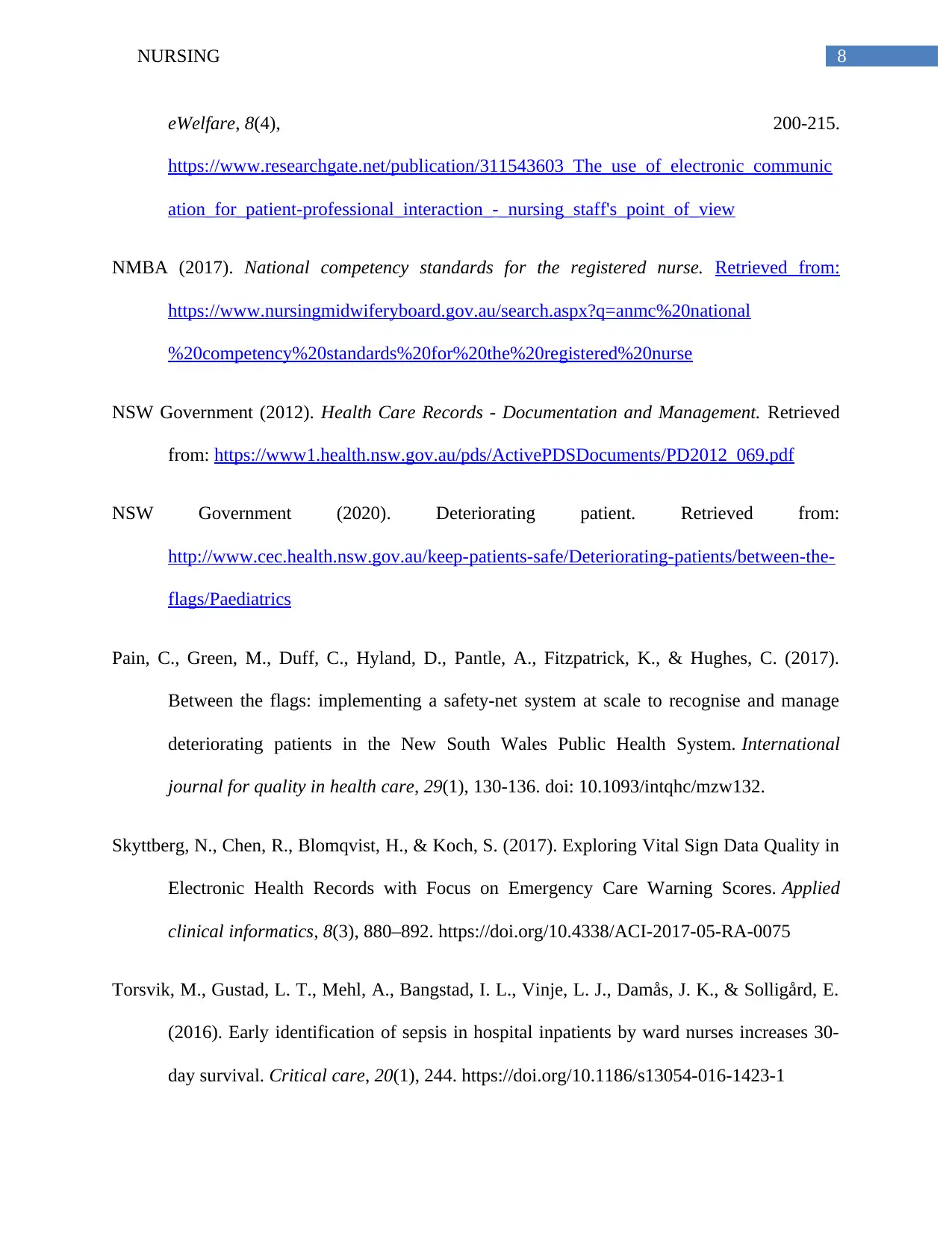
8NURSING
eWelfare, 8(4), 200-215.
https://www.researchgate.net/publication/311543603_The_use_of_electronic_communic
ation_for_patient-professional_interaction_-_nursing_staff's_point_of_view
NMBA (2017). National competency standards for the registered nurse. Retrieved from:
https://www.nursingmidwiferyboard.gov.au/search.aspx?q=anmc%20national
%20competency%20standards%20for%20the%20registered%20nurse
NSW Government (2012). Health Care Records - Documentation and Management. Retrieved
from: https://www1.health.nsw.gov.au/pds/ActivePDSDocuments/PD2012_069.pdf
NSW Government (2020). Deteriorating patient. Retrieved from:
http://www.cec.health.nsw.gov.au/keep-patients-safe/Deteriorating-patients/between-the-
flags/Paediatrics
Pain, C., Green, M., Duff, C., Hyland, D., Pantle, A., Fitzpatrick, K., & Hughes, C. (2017).
Between the flags: implementing a safety-net system at scale to recognise and manage
deteriorating patients in the New South Wales Public Health System. International
journal for quality in health care, 29(1), 130-136. doi: 10.1093/intqhc/mzw132.
Skyttberg, N., Chen, R., Blomqvist, H., & Koch, S. (2017). Exploring Vital Sign Data Quality in
Electronic Health Records with Focus on Emergency Care Warning Scores. Applied
clinical informatics, 8(3), 880–892. https://doi.org/10.4338/ACI-2017-05-RA-0075
Torsvik, M., Gustad, L. T., Mehl, A., Bangstad, I. L., Vinje, L. J., Damås, J. K., & Solligård, E.
(2016). Early identification of sepsis in hospital inpatients by ward nurses increases 30-
day survival. Critical care, 20(1), 244. https://doi.org/10.1186/s13054-016-1423-1
eWelfare, 8(4), 200-215.
https://www.researchgate.net/publication/311543603_The_use_of_electronic_communic
ation_for_patient-professional_interaction_-_nursing_staff's_point_of_view
NMBA (2017). National competency standards for the registered nurse. Retrieved from:
https://www.nursingmidwiferyboard.gov.au/search.aspx?q=anmc%20national
%20competency%20standards%20for%20the%20registered%20nurse
NSW Government (2012). Health Care Records - Documentation and Management. Retrieved
from: https://www1.health.nsw.gov.au/pds/ActivePDSDocuments/PD2012_069.pdf
NSW Government (2020). Deteriorating patient. Retrieved from:
http://www.cec.health.nsw.gov.au/keep-patients-safe/Deteriorating-patients/between-the-
flags/Paediatrics
Pain, C., Green, M., Duff, C., Hyland, D., Pantle, A., Fitzpatrick, K., & Hughes, C. (2017).
Between the flags: implementing a safety-net system at scale to recognise and manage
deteriorating patients in the New South Wales Public Health System. International
journal for quality in health care, 29(1), 130-136. doi: 10.1093/intqhc/mzw132.
Skyttberg, N., Chen, R., Blomqvist, H., & Koch, S. (2017). Exploring Vital Sign Data Quality in
Electronic Health Records with Focus on Emergency Care Warning Scores. Applied
clinical informatics, 8(3), 880–892. https://doi.org/10.4338/ACI-2017-05-RA-0075
Torsvik, M., Gustad, L. T., Mehl, A., Bangstad, I. L., Vinje, L. J., Damås, J. K., & Solligård, E.
(2016). Early identification of sepsis in hospital inpatients by ward nurses increases 30-
day survival. Critical care, 20(1), 244. https://doi.org/10.1186/s13054-016-1423-1
⊘ This is a preview!⊘
Do you want full access?
Subscribe today to unlock all pages.

Trusted by 1+ million students worldwide
1 out of 9
Related Documents
Your All-in-One AI-Powered Toolkit for Academic Success.
+13062052269
info@desklib.com
Available 24*7 on WhatsApp / Email
![[object Object]](/_next/static/media/star-bottom.7253800d.svg)
Unlock your academic potential
Copyright © 2020–2025 A2Z Services. All Rights Reserved. Developed and managed by ZUCOL.





